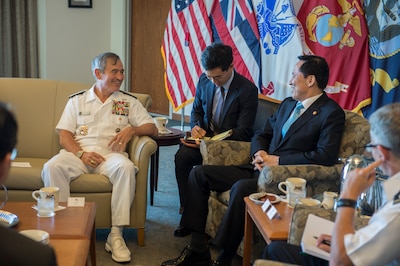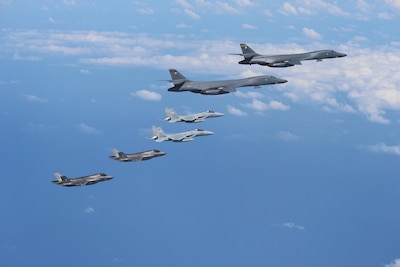By Cheryl Pellerin DoD News, Defense Media Activity
WASHINGTON, Sept. 1, 2017 — The commander of U.S. Northern
Command delivered a message from Defense Secretary Jim Mattis to the people of
Texas today during an update on Hurricane Harvey from the Texas State
Operations Center in Austin, Texas.
Texas Gov. Greg Abbott led the update on the Category 4
hurricane that since Aug. 27 has devastated southeastern Texas, and he
summarized the Federal Emergency Management Agency-led and ongoing rescue and
restoration operations there, before introducing Air Force Gen. Lori J.
Robinson.
On behalf of Mattis, Joint Chiefs Chairman Marine Corps Gen.
Joe Dunford and the men and women of the armed forces, Robinson expressed hope
for the people affected by the storm. "I would like to offer our heartfelt
thoughts and prayers to all of those who have been affected by Hurricane
Harvey," she said.
In her role as Northcom commander, the general said, she is
responsible for deploying active duty soldiers, sailors, airmen and Marines to
support FEMA and state requests for assistance to local, county, state and
federal civil authorities in devastating times.
"When disasters of this magnitude strike, a
whole-of-government response is necessary, and DoD is a part of all of
that," Robinson said.
Right Capability, Right Time
The military has learned over time how important it is to
have the right capability at the right place at the right time to support the
needs of citizens, the general said. "Our military has unique capabilities
to support disaster relief, and those same capabilities that make our armed
forces so effective in combat make our forces uniquely effective in disaster
relief efforts, she added. "We have been and we will continue to deploy
any and all capabilities requested by FEMA and [the state of Texas]."
Robinson said she had a conversation yesterday with Mattis.
"He made the comment to me: 'Lori, Texas gets everything they need, and
we'll get it there as fast as we can,'" she said.
Military Contribution
"I'm so proud of the soldiers, sailors, airmen and
Marines that have deployed in the affected area and that will continue to
deploy as long as requested and needed," Robinson said, and she summarized
the military contribution so far to the affected areas in Texas:
-- The Army has provided 200 high-water vehicles to support
the Red Cross in the moving personnel and patients. Army helicopters with
hoisting capability are helping to rescue and transport survivors, and the Army
is overseeing the receipt and issue of life-support items.
-- The Air Force is providing strategic airlift, fixed-wing
airlift, medical evacuation, airborne command and control, and helicopters to
transport people and supplies.
-- Navy amphibious ships USS Kearsarge and USS Oak Hill,
along with Marines from the 26th Marine Expeditionary Unit, are en route to
Texas should the state need them.
-- The Defense Logistics Agency has provided fuel, sandbags,
generators and incident-support bases and is delivering meals to dislocated
citizens.
-- The U.S. Army Corps of Engineers has deployed experts to
the state and to FEMA, and response nodes to help provide technical assistance
with power restoration.
These are just a few things the men and women in uniform are
doing to help with the larger relief effort, Robinson said. "We are
committed to assist local, state and federal agencies throughout this trying
time for our nation," the general added.
Robinson also thanked the governor and other officials
involved in overseeing the response for their leadership. "We look
forward," she said, "and we will be there -- steady, ready and to
support at a moment's notice."










